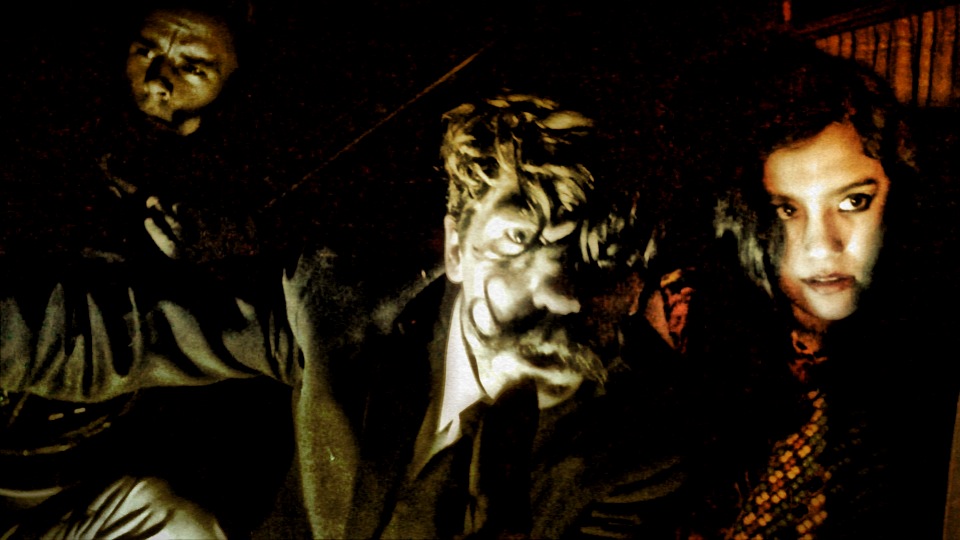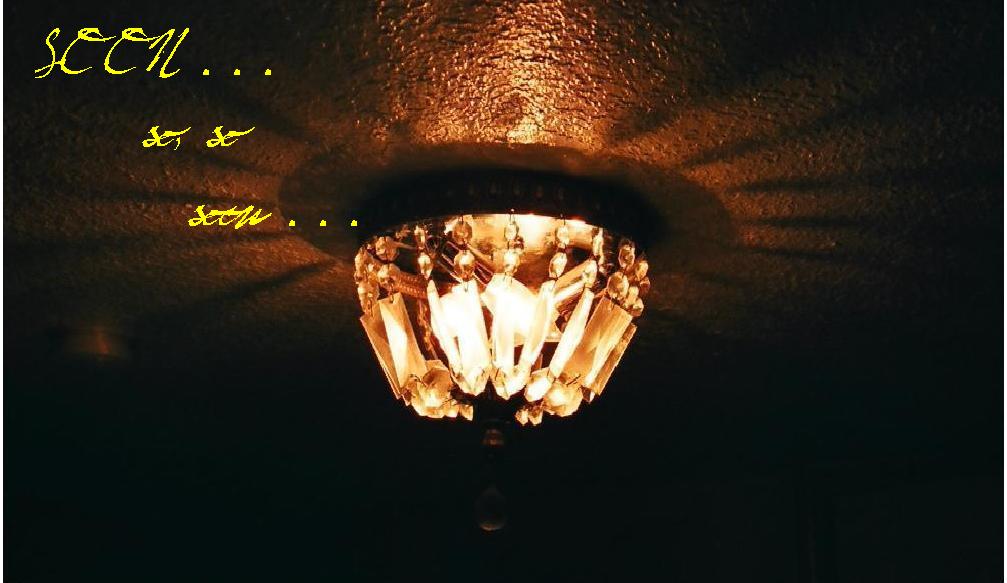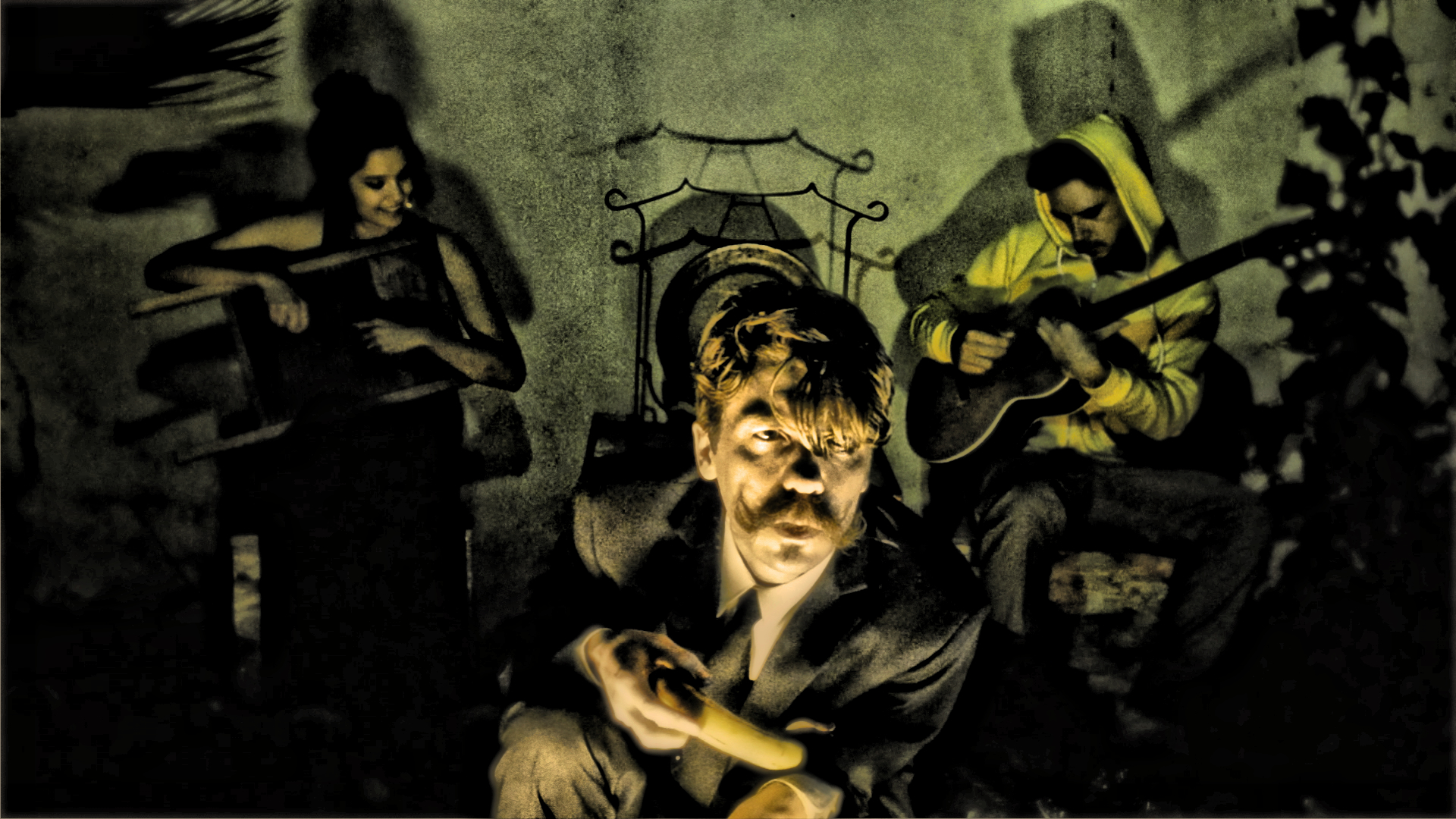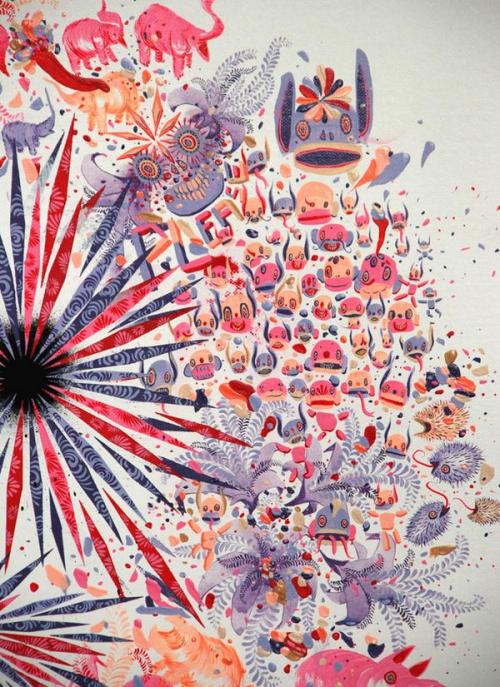

Otkačeni književnik Zack Wentz (The Garbageman and the Prostitute, časopis New Dead Families), Taj Easton i Shelby Gubba pokrenuli su multimedijski prokekt nazvan (Charles)Book&Record. Doasad su izdali tri video-spota a njihov prvi album je Leftover Magic.
streaming
charlesbookandrecord.com/
(Charles) Book & Record: "Sentimental Ape (xiu Xiu Remix)"

San Diego is the eighth-largest city in the United States, but has never made a comparably-sized impact on the music scene. Although legendary groups have come and gone (Drive Like Jehu, The Locust), the scene remains tenuous, dependent on the transient student population and regularly depleted by the magnetic pull of Los Angeles and San Francisco. However, nestled among the sunburned suburbs and fueled by the spoils of ubiquitous, world-beating Mexican cuisine, a micro-scene has sustained itself. One of the most beguiling recent emanations from the city is (Charles) Book & Record, a trio consisting of authorZack Wentz (late of Kill Me Tomorrow), dedicated Planned Parenthood staffer Shelby Gubba and engineer Taj Easton ( a specialist in Rammed Earth housing: dwellings constructed from natural materials). This pedigree only serves to deepen the mystery of their latest missive, a Xiu Xiu remix of the track "Sentimental Ape" from their just-released Leftover Magic cassette.
Leftover Magic is available now from (Charles) Book & Record.
Remixes are forthcoming from Rafter, Xiu Xiu, and FUNERALS, as well as a serialized movie, related to the band/album, entitled Bad Dreamer. Taj Easton and Zack Wentz were also commissioned to create a soundtrack for the short Andy Mingo film Romance, based on a short story by Chuck Palahniuk (Fight Club), which debuted in London at the Raindance Film Festival in the fall of 2012.

Geek is proud to present “Sentimental Ape” the second video in (Charles)Book&Record’s triptych of videos introducing the new band to the world. (The first video premiered on Juxtapoz). (Charles)Book&Record is the mysterious new musical endeavor of San Diego’s Zack Wentz, who previously made a lot of really intense, futuristic music in the criminally underrated Kill Me Tomorrow. Also a former member of Tender Buttons and The Dabbers, Wentz joined forces with his wife and Dabbers band mate Shelby Gubba and engineer Taj Easton to create (Charles)Book&Record.
I can’t really describe their sound better than the band does: there is no doubt that (Charles)Book&Record have created some intoxicating “sci-fi-surrealist-soul.” Their debut album Leftover Magic will be released digitally in January and will feature all three songs from the triptych.
Wentz, who is never really satisfied to simply release music (Kill Me Tomorrow’s album The Garbageman and the Prostitute was accompanied by a stellar novel of the same name. It’s out of print, but you can get it used at Amazon has big plans for (Charles)Book&Record. Most notably Wentz and Easton are creating a serialized film based on the record entitled Bad Dreamer. (In related news, Easton and Wentz were also commissioned to create a soundtrack for the short Andy Mingo film Romance, based on a short story by Chuck Palahniuk (Fight Club), which debuts in London at the Raindance Film Festival this fall.) -
www.geekexchange.com/
 In case you were recently perusing photos of this last Halloween and feeling nostalgic about pseudo-creepiness and absurd get-ups, there are ways to bring yourself back to that time. If you are a fan of fine literature, an Edgar Allan Poe a short story is a perfect solution. If you prefer music videos, then this one provided by (Charles)Book&Record can potentially satiate your need. Based out of San Diego, (Charles)Book&Record creates music that pulls from an array of influences and comprises of bandmates with various, unlikely backgrounds creating a sound can be described as "invigorating, densely-textured, darkly-melodic pop that owes as much to classic calypso, traditional song, and crooner-era swing as it does to 80's art-rock, Berlin School electronic music, and vintage R&B" (to quote their own self-description). The video itself (a first episode of a trilogy) explores an array of disjointed, strange and associational imagery that shudders from frame to frame with a visual stylization that very much mimics the bands sound itself.
In case you were recently perusing photos of this last Halloween and feeling nostalgic about pseudo-creepiness and absurd get-ups, there are ways to bring yourself back to that time. If you are a fan of fine literature, an Edgar Allan Poe a short story is a perfect solution. If you prefer music videos, then this one provided by (Charles)Book&Record can potentially satiate your need. Based out of San Diego, (Charles)Book&Record creates music that pulls from an array of influences and comprises of bandmates with various, unlikely backgrounds creating a sound can be described as "invigorating, densely-textured, darkly-melodic pop that owes as much to classic calypso, traditional song, and crooner-era swing as it does to 80's art-rock, Berlin School electronic music, and vintage R&B" (to quote their own self-description). The video itself (a first episode of a trilogy) explores an array of disjointed, strange and associational imagery that shudders from frame to frame with a visual stylization that very much mimics the bands sound itself. 



New Dead Families
In some alternate universe there is my ideal periodical: a cross between H.L. Gold’s Galaxy, and Gordon Lish’s the Quarterly, and/or Michael Moorcock’s New Worlds and Bradford Morrow’s Conjunctions. In the 70’s there were a number of original paperback anthologies that came close: Damon Knight’s Orbit series, Judith Merril’s numerous SF bests, and Harry Harrison’s Nova.
But where are those sorts of literary venues now? Where could that kind of work go now?
Perhaps New Dead Families is that periodical, in that place, and by some quantum trick I have pushed/pulled that alternate universe into my own. This.
Perhaps.
We can certainly try, can’t we?
New Dead Families
an outing, a get-together, a reunion
Upon taking into consideration the very real and rapid crumbling of virtually every paying market for creative work in this nearly post-product arts culture we are collectively finding ourselves floundering in, one might imagine that the genre tags separating commodity countries such as “literary” and “science fiction” would likewise disintegrate. Folks have been talking about this for a good while now, and considerable progress has been made in that direction, but it still isn’t quite the case; immigration is allowed, but the immigrants in question must be willing to learn the lingo, adopt aspects of regional manners, and make whatever other concessions are required to blend in, in order to earn and keep their green cards.
In spite of SF (science fiction or speculative fiction–the latter tag never fully stuck, and it doesn’t matter much which you choose to apply) and fantasy being far older modes of storytelling than literary fiction (particularly naturalist/realist fiction), and that the most prominent form of literary fiction, the modern short story, was practically invented by Hoffmann, Poe, Hawthorne, Gogol, Irving, the Brothers Grimm, etc., the submission guidelines of 99.9% of literary publications still specify “no genre fiction,” and quite often “no science fiction,” as if capital L Literature (what they presumably publish) is both outside and above such a designation.
(This discussion might be old-hat to some, but bear with me; it might not be to others.)
What defines literary? We have to re-ask ourselves this every generation or so, as the criteria have never been quite clear, but finer, more stylish prose, and depth of character have been most frequently cited as distinguishing features over time (although the latter element has declared kaput in more avant-garde circles at multiple points over a dozen or so past decades). Basically, literary merit is doled out for aesthetic value. If this sounds like two indefinable words used to refer to the same thing in order to set up a sort of Potter Stewart “I know it when I see it,” self-perpetuating, sliding standard, well, that’s no accident, and every few years a John Gardner or B.R. Myers pops up and gets crankily indignant about what he sees as egregious exploitations of this all-too-convenient arrangement. Overall, the implication is that literary writing is writing that is consciously written well, therefore anything that is genre (ie not literary) just isn’t written well enough.
Of course only the most myopically minded grad-student would buy that whole-heartedly (or whole-headedly–too often the heart doesn’t seem to have a hell of a lot to do with these matters), and even Harold Bloom, Mr. Literature himself, dedicates a generous portion of his mighty canon to SF and “genre” fiction (his own sole published attempt at a novel was actually a sequel to David Lindsay’s Voyage to Arcturus).
Regardless, right now it is becoming more apparent than ever that the quaint neighborhood of literature is as much of a ghetto as any page-turner-tenderloin ever was, and only tentatively maintains the precious sheen of respectability due to its insular connection to various institutions of higher-priced learning.
It goes both ways. Most SF magazines are apt to turn down any submissions without enough ideas or genuine scientific implications, and any language tricks, darling sentences, and faddish forms that might reek of the workshop will get you unceremoniously kicked out of the lab. No “slumming” allowed.
Of course nobody who’s buying, and has a reputation of one form or another on the line, wants a bad story, and the simplest methods of determining whether something is bad or not, especially when you have a tremendous inbox of manuscripts to sort through, is the age-old process of hastily discriminating against surface characteristics. For instance: a lit-mag, if pushed to choose, would rather publish a cliché-ridden, trendy story by an oft published MFAster than an ingeniously well-crafted, poignant and poetic tale that unfortunately seems to contain tropes that “reek of geek,” submitted by some un-graduated oaf who the editor, intern, or lit-lackey, has never heard of. Likewise an SF mag would rather publish a “much ado about nano,” post-cyberpunk-yawner by a name in the field than tour de force of mind-bending linguistic pyrotechnics and uncanny psycho/spiritual insight by some utterly doomed, would-be poetic genius who clearly doesn’t get out to conventions enough.
There have always been crossovers, from Wells, to Kipling, Shaw, London, Sinclair Lewis, E.M. Forster, Waugh, Orwell, Huxley, Lessing, etc. on. The most ambitious, if not infamous, literary novels attempted in the last few generations, Infinite Jest and Gravity’s Rainbow, have it both ways. Many of the most popular and influential authors of the moment, Erickson, Marcus, Evenson, Bender, Millhauser, Atwood, Murakami, Saunders, Millet, Letham, Link, Chabon, Auster, Shelley Jackson, the recently rediscovered and re-emergent David Ohle, etc. have inspired droves of student and aspiring writers to incorporate SFish language and riffs into new work, as filtered by their sensibilities, and some of the most respected and popular literary magazines, Conjunctions and McSweeney’s among them, have dedicated space to these hybrids. Similar gestures have been made on the SF end: the unfortunately dubbed mundane SF, new weird, and slipstream, and the SF camp also has their outstanding figures who have had some success at establishing dual-citizenship: VanderMeer, Mieville, Jeff Ford, James Patrick Kelly, Steve Aylett, alongside older stalwarts like Moorcock, Delany, Priest, Crowley, M. John Harrison, Gibson, etc.
I’m not really getting at anything revelatory here. The new wave of fabulism isn’t so different from the magic realism or new wave SF of the 60’s and 70’s (and I’ll get into both of these later on). You can find discussions regarding the bridging of this schism numerous places online, whether it’s possible, desirable, or just: “What books could I use to turn my lit-snob friend/significant other on to SF?” There’s a wealth of great interstitial stuff already out there, being created, and still emerging.
With any luck, the prejudices and so-called standards clung to for the sake of maintaining purity and keeping an identity defined are being washed away with the last of the money the whole fiction industry is just about done hemorrhaging, and we’re moving toward integration to the point of genre color-blindness, to where the genuine qualities and merits of the art of fiction can shine more brightly than its sunglasses, with more imagination and speculative daring in the lit camp, and greater willingness to experiment with language and form in the SF camp. The impulse and interest in merging is there, the idiomatic writing is on the wall, etc., hurrah, but . . . I still just don’t see a proper, fully-stretched place for “it” yet, venues catering more exclusively to this range of carefully crafted imaginative literature, or perhaps just not enough of them.
So: I would like more people now to read more of what I think is the best of both worlds, past and present, and I intend to both publish, publicize, and celebrate that sort of work here: New Dead Families.
In our debut issue you’ll find an exceptional selection of stories and visual art by a variety of writers and artists I both admire and enjoy. More are forthcoming. I’ll also provide recommendations galore, and as much commentary as I can manage, probably along with the occasional recipe, or rant, so hang about if you like, friends, and let’s see what comes of it.
In the meantime: take care, and keep it surreal;}
Your pal,
Zack
“Triffids at Prayer” by: Shelby Wentz
- The Future of Festering Wounds by: Jamie Grefe
- Works by: Aidan Koch
- Incident Report #6320.116 by: Lloyd Philips
- Cherry Blossom Season by: Zach Polis
- A Brief History of an Amputee by: Cameron Pierce
- Cernunnos by: Karn Piana
- Lung Gloss by: Gary J. Shipley
- Final War (an excerpt) by: Barry N. Malzberg
- Contributors

Jason Xavier Lane
- From: Lies w/Exceptions by: Andrew Borgstrom
- The Piglet by: Michael Hickins
- Works by: Heather Gwen Martin
- Downtown at Baboonsasshole by: Mike Coppolino
- It’s Time by: Tantra Bensko
- Demon Drawings by: RC Miller
- Six Haiku by: Jamie Stewart
- LisaLisaLisaLisaLisaLisaLisa by: Swan
- Gollypods by: Jason Xavier Lane
- The Fall (an excerpt) by: J.S. Breukelaar
- Contributors

Noah Doely
- Paper Nautilus by: Kirsten Alene
- Works by: Jfre Robot Coad
- Volunteers (Excerpt From a Novel in Progress) by: Grace Krilanovich
- How to Breathe by: Joseph Goosey
- Diary of the Possessed by: David Peak
- Works by: Michael J. McCardle
- Excerpts from The Old Reactor by: David Ohle
- Magic Show by: Bradley Sands
- Contributors
“Let’s Make a Deal” by Sam Luke
- Prelude by: Barry Yourgrau
- Half a Block Away by: Alvaro Zinos-Amaro
- Selections from DOME by: Tetsunori Tawaraya
- Wherein the New King Speaks on the Subject of the Flesh of Whales by: Robert Kloss
- Vintage Service Medal of the “Urchin Detonators” Adolescent Engagement Brigade, circa 2022-28 by: Jennifer Oakes
- To Make Us Whole by: Amber Sparks
- The Gift Giver by: Sonny Kay
- Sometimes Always is Born by: David Backer
- The Glorious Palace of Our Ancestors by: I. Fontana
- Contributors



Nema komentara:
Objavi komentar